People hear facts, but feel stories, and medical storytelling today is a winning combination of both.
In 2013, Novartis broke the mold in marketing with its campaign for its oral multiple sclerosis treatment Gilenya. The campaign, “Hey MS, Take This!" shows various patients sticking out their tongues with Gilenya capsules on them.
Novartis reported that the idea for the campaign’s upbeat, feisty, and sassy tone came from what they heard from patients who expressed themselves on social media, saying they would not let the disease stop them from living their full life. For many, this arguably was the beginning of creative medical storytelling.
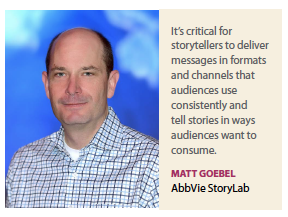 According to Charley Aldridge, group creative director at Intouch Proto, this campaign was a defining moment for the industry. “Gilenya took a very real insight and feeling from a community whose mobility is greatly affected by MS and its current treatments and turned it into a narrative that helped launch the brand in a big way," he says. “For me, the “Take This" campaign really made me proud of my industry."
According to Charley Aldridge, group creative director at Intouch Proto, this campaign was a defining moment for the industry. “Gilenya took a very real insight and feeling from a community whose mobility is greatly affected by MS and its current treatments and turned it into a narrative that helped launch the brand in a big way," he says. “For me, the “Take This" campaign really made me proud of my industry."
Mr. Aldridge says since then, there have been many more examples of industry marketers using medical storytelling in an intelligent, clever, and creative way.
AbbVie is a company that is well-aware of the importance of storytelling, and created StoryLab, a content development group that creates content for all segments of the company. The focus is on storytelling and the group has initiated a move toward using relevant, engaging, and authentic content as the foundation of AbbVie’s growth, value, and reputation stories.
“Stories can provide an inside look at the passion and commitment of people and the impact a company can make," says Matt Goebel, director, AbbVie StoryLab. “Stories describe a problem or a challenge, a solution and the result, as well as the person or people involved."
A successful medical storytelling campaign should make a difference in consumer behavior. Stories should use simple and straightforward language to help make the complex understandable and meaningful, he adds.
For example, AbbVie created a successful campaign called “Scientists Rock!"
designed to humanize the company’s scientists. The program is a monthly Q&A where an AbbVie scientist is featured in a personal way so others can learn what makes him or her tick. The profiles highlight their families, hobbies, education, and other characteristics that define the scientist as a person. “For this campaign and many others, we monitor conversations on social media and we receive comments from patients and physicians that include, ‘thanks for helping me understand what your company does,’" Mr. Goebel says. “Our goal when it comes to storytelling is to ensure our audiences understand what AbbVie is and the impact we make."
Creating the Story with Characters
David Mustalish, M.D., senior VP, medical director at Intouch Solutions, notes that this shift toward storytelling is growing throughout the industry. “A few decades ago, there was less emphasis on messaging to consumers," he says. “Today there is a growing appreciation of the importance of the patient in the decision-making process."
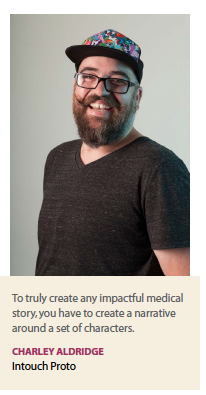 This is also true on the physician side, he adds. “HCP messaging was effectively a data dump. There is an understanding now that it’s okay to appeal to both the emotional and rational aspects of physician behavior," Dr. Mustalish says.
This is also true on the physician side, he adds. “HCP messaging was effectively a data dump. There is an understanding now that it’s okay to appeal to both the emotional and rational aspects of physician behavior," Dr. Mustalish says.
Explaining a complicated health issue or a high-science mechanism of action in such a way that people can understand the concepts is a big challenge in creating a medical story. One way to meet the difficulties is to assign a voice or a personality to the topic, so it can be explained in analogous ways that patients and physicians can quickly grasp.
“To truly create any impactful medical story, you have to create a narrative around a set of characters," Mr. Aldridge explains.
For example, in the disease state of hemophilia, both physicians and patients and everyone connected with the disease know and use the word “factor," which identifies the missing or defective factor VIII, a clotting protein, that causes hemophilia. If a story were to be created, factor would be positioned as the central character of the tale, given a personality or a voice, so everyone can easily identify with it. “Everyone affected by this condition from the doctors who treat it, to the patients who use it, to the parents and caregivers who help administer treatment talk almost exclusively about factor," Mr. Aldridge says. “Factor is the hero of their story."
However, what if a new way to treat hemophilia came along; what would be the best way to educate everyone on how it works? A new way of treating the disease would bring new language and new processes into the conversation that most people would not be familiar with. Mr. Aldridge says if he were exploring a way to introduce a different way to treat hemophilia that didn’t include or was less dependent on factor, he would present the new treating compound as another character in the hemophilia treatment story. He says how a new character is introduced is critical to the success of any future treatment. He would start by asking questions like: How do you replace a beloved hero like Factor? Is this new compound friends with Factor? Do they work together? Are they enemies? Or simply is this new compound a new/better hero? Does it make Factor obsolete?
“All of these things need to be considered when trying to create an impactful medical story," Mr. Aldridge says. “And out of all of this, the No. 1 thing you must consider is how is your audience — patient, HCP, or other group — going to react to the introduction of the new character? This is why listening to your audience and testing your story is key when developing a new medical narrative."
Like most stories, medical storytelling needs to ring true to the audience. The easiest way to accomplish an authentic narrative is to tell the truth, use real people and situations, and make sure the story is relatable to the intended audience.
“Authenticity can result from stories featuring the voices of employees and patients," Mr. Goebel says. “For example, scientists can talk about an experiment’s failure, their first science project, and what keeps them up at night.
It’s also authentic to show them doing what they love outside of work, like bicycling in a race or on a family vacation. Anecdotes about their personal lives or careers help show vulnerability and moments of learning."
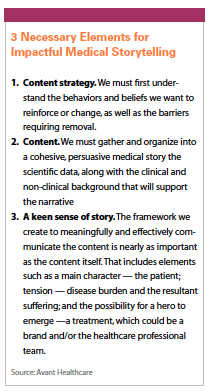 “The more you can use real patient examples and real HCP experiences to inform your story, the better," Mr. Aldridge adds. “People believe you when you tell the truth. So, find your story’s most compelling truth and say it, over and over, until you are sure your audience heard you."
“The more you can use real patient examples and real HCP experiences to inform your story, the better," Mr. Aldridge adds. “People believe you when you tell the truth. So, find your story’s most compelling truth and say it, over and over, until you are sure your audience heard you."
However, authenticity in medical storytelling can often present challenges because of the inherently strict requirement for total alignment with the label, in addition to presenting a full and balanced picture of the disease impacting the main character (the patient). Meeting these challenges requires representing the patient and the disease in the most realistic of terms and details. “Frequently, the more detail we can provide the audience about that main character, the more the story will resonate," says Rob Spalding, chief strategy officer at Avant Healthcare. “The authenticity will vary to some extent because the story can differ across audience segments. That’s OK — it’s important to understand to the greatest extent possible a segment’s biases and then attempt to address those biases, partnering with medical, legal, and regulatory teams to create as close to a real main character as possible from the audience’s perspective."
Stories Work for Patients, Physicians, and KOLs
Whether the audience is patients, physicians, or KOLs, storytelling remains a meaningful way to create relationships, inform and educate consumers, and build on a brand. While the individual stories, the language used, and how they’re told will obviously differ greatly between audiences, the approach and framework for developing a story are the same, Mr. Spalding says. “Even within those audience segments the emphasis of the key elements, the level of detail, and the balance of rationality versus emotion can differ based on the challenge the story is attempting to address," he says.
Mr. Aldridge says there is some difference between physician and patient storytelling, but not much.
“We’re all taking the train to the same place, but for HCPs it’s more about giving them the reasons why they should get on the train, which translates into compelling efficacy information, a reasonable safety profile, or how a novel mechanism of action works," he says.
“For patients, it’s more about explaining what the train is made of: what exactly is their disease or condition and why do they have it; how is the disease or condition going to affect them now and in the future; what are the treatment options and which one is best. For many patients, this may be the first time they’ve ever heard of the train, and they didn’t want to take a ride on it in the first place."
Dr. Mustalish, a medical director himself, says he has seen many medical stories that are accurate but fail to educate or be effective. “Just because you can say something, doesn’t mean it is differentiating," he cautions. “And just because something is differentiating, doesn’t mean it is compelling." He notes that marketers need to identify “the why" of the story, as it is often more important than the why.
Another point Dr. Mustalish makes is that physician and patient stories need to align with each other for better communication between the two parties.
 “While we have the ability to better target diverse stakeholders with different messages, these communications don’t live in a vacuum," he says. “When we communicate to patients and encourage them to open a dialogue with their HCP, we need to ensure that this conversation aligns with what the physician understands. The story of the treatment may be the same, but what is important in that story and the way in which we tell it depends on the audience," he says.
“While we have the ability to better target diverse stakeholders with different messages, these communications don’t live in a vacuum," he says. “When we communicate to patients and encourage them to open a dialogue with their HCP, we need to ensure that this conversation aligns with what the physician understands. The story of the treatment may be the same, but what is important in that story and the way in which we tell it depends on the audience," he says.
At AbbVie, the story team tries to communicate the company’s story by talking about the work being done and the people doing it. Both patients and physicians are bombarded with messages every day, so AbbVie targets both audiences with stories that demonstrate the impact of 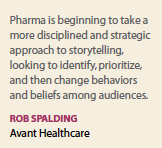 helping people treat their diseases, such as the aforementioned Scientists Rock! program.
helping people treat their diseases, such as the aforementioned Scientists Rock! program.
“Sometimes it might be a long-form story and sometimes it’s a short story, video, or infographic," Mr. Goebel says. “For the general public and patients, we know they want to hear about medical advancements as well as how diseases impact daily lives."
According to Mr. Spalding, stories also work well for medical education. “They are a great avenue to help an audience hear from KOLs or medical professionals in their field that they respect and admire," he says. “People are more apt to listen when they know that the person talking to them has relevant experience that could help them when making treatment decisions."
Looking through a wider lens, storytelling can help content resonate even more with those who arguably matter most: the potential speakers whose enthusiasm can further impact, excite, and motivate their audiences to action.
Mr. Spalding relates an anecdote highlighting a positive outcome. A client’s brand team was working with a KOL — arguably the top in his field. He politely declined the brand team’s requests to present promotional programs on their behalf.
When the brand team created a presentation for someone else to give, they applied storytelling approaches and framed the content into video bookends that defined the science 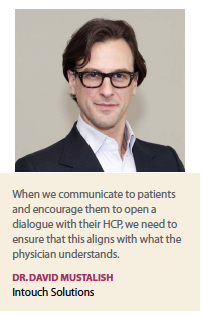 in human terms. “We visually conveyed patients’ impatience and frustration with their illness using the body parts most affected by that illness; we showed the patients tapping their hands and feet or kneading their toes," Mr. Spalding explains. “At the end of the story, those same patients could be seen using those same parts for their intended purposes, like walking and holding hands."
in human terms. “We visually conveyed patients’ impatience and frustration with their illness using the body parts most affected by that illness; we showed the patients tapping their hands and feet or kneading their toes," Mr. Spalding explains. “At the end of the story, those same patients could be seen using those same parts for their intended purposes, like walking and holding hands."
Upon seeing the final presentation, the usually reluctant KOL reconsidered and offered to present the content, which was a huge win for the client.
“Not only did the KOL share with the audience his enthusiasm for the video bookends, he mentioned that the quality and depiction mirrored the client’s direct-to-consumer efforts and exemplified the company’s commitment to patients," Mr. Spalding says.
This example shows the power of medical storytelling at its best, making a difference in outcomes across the brand, across physicians and KOLs, and most importantly for patients. End of story.(PV)
~~~~~~~~~~~~~~~~~~~~~~~~~
3 Necessary Elements for Impactful Medical Storytelling
1. Content strategy. We must first understand the behaviors and beliefs we want to reinforce or change, as well as the barriers requiring removal.
2. Content. We must gather and organize into a cohesive, persuasive medical story the scientific data, along with the clinical and non-clinical background that will support the narrative
3. A keen sense of story. The framework we create to meaningfully and effectively communicate the content is nearly as important as the content itself. That includes elements such as a main character — the patient; tension — disease burden and the resultant suffering; and the possibility for a hero to emerge —a treatment, which could be a brand and/or the healthcare professional team.
Source: Avant Healthcare
~~~~~~~~~~~~~~~~~~~~~~~~~
Insights from an Agency/Client Partnership
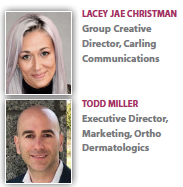 Lacey Jae Christman
Lacey Jae Christman
Group Creative
Director, Carling Communications
Todd Miller
Executive Director, Marketing, Ortho Dermatologics
It’s an exciting time for storytelling in healthcare. With social media becoming a huge part of how consumers get their information, KOLs and brand influencers are reaching HCPs and patients in a whole new way. This has the marketing world rethinking how it delivers information and how it’s consumed. How this media is regulated will inevitably dictate how the market evolves over the next five to 10 years. Going forward, there’s no doubt we will continue to use storytelling as a way to provide clinical and promotional messaging, but within which medium and how those messages are consumed will evolve as we continue to explore new and unique ways to deliver them.
The end goal of marketing is to have people take action. By creating a story built on emotional benefits you can create a deeper connection that results in an emotional response. This connection goes beyond rational reasoning, but you need to back that up with improved patient outcomes. If your brand doesn’t deliver on its promise, your emotional connection will fail. HCPs are consumers but they need to know the functional benefits as well. The difference is the medical story has to include scientific proof that the treatment works. It can’t be dismissed. Because while HCPs may be influenced or emotionally inspired by a campaign, their end goal is to improve patients’ lives.
Just because you have a great story doesn’t mean your story will get heard. That is where the creative aspect of a campaign can separate the story from all the noise in the market. The campaign along with the medium chosen will help get an audience to pay attention to the story.
Marketers need to find a compelling reason for the audience to want their brand over what they are currently using or to activate them, such as the case of a consumer not being treated. It may be efficacy, convenience, a different formulation, fewer side effects, etc. but once you uncover that, you can make it part of your story.
















